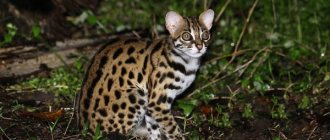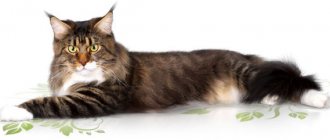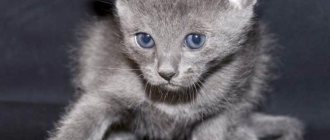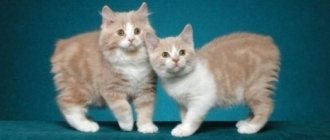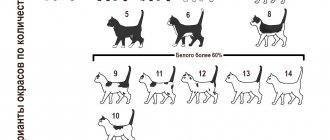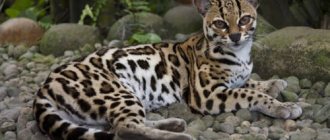Basically, our compatriots associate a cat with such a fluffy ball purring on the owner’s lap. But there are a lot of different breeds in the world that are radically different from stereotypical ideas.
Sometimes there are breeds and species that an unprepared person cannot look at without opening his eyes wide in surprise. They differ in size, habitat area, coat length, etc., but they are all united by their unique grace and habits.
Dune cat
sand cat- Dune cat
Historical origin and natural habitat
The sand dunes of the Sahara are the historical habitat of this cat species. It is from the place of origin that the animals got their name. In the desert, kittens were first seen by members of the expedition led by Jean Auguste Marguerite.
Dune cat in nature
People were surprised by the endurance of the inhabitants of the sands and how well the dune cat felt in the desert. Sahara is characterized by sub-zero temperatures at night and extreme heat during the day. Animals, which later received another name - sandy ones, feel good precisely in the most arid climate: in Central Asia, on the Arabian Peninsula, in Pakistan. These points on the planet are the natural habitat of purebred representatives.
For reference! Many people mistakenly call representatives of the breed a velvet cat or cat. These animals have nothing to do with velvet.
History of the species
The Little Desert Cat entered history in a very unusual way. The fact is that this species of cat was discovered twice.
In the middle of the last century, the French general Jean Auguste Marguerite organized an expedition to the Sahara Desert. Scientists discovered representatives of a new species of cat on the border of Libya and Algeria. The unusual cat was named in honor of the general who led the expedition - Felis margarita. The description was made by the French naturalist Victor-Jean-François Loshomme.
At the beginning of the next century, a Russian expedition led by Moscow explorer Sergei Ognev studied the Kara-Kum and Kyzyl-Kum deserts. They also met an unusual small desert cat and recorded the discovery of a new species.
Later, the misunderstanding was resolved - French scientists simply discovered a North African variety, and Russian scientists discovered an Asian one.
The sand cat is often called the Arabian or Sand cat. However, the name “velvet” is incorrect. The name of the animal is caused by associations with the dunes, among which it was found, and not with velvet.
What scientists still cannot explain is how this species of cat arose in the deserts and how it adapted to life in incredibly difficult conditions. The animals look so cute and seem so harmless that their very existence in the sands has given rise to many legends and fairy tales. Here is one of them about a tribe of people living in the desert more than four thousand years ago:
The leader of the community had a son who loved to draw on stones. When the tribe was attacked by enemies, one of the elders managed to turn the boy into a cat. He had to get to the nearby allied camp and call on them for help. When the soldiers arrived at the scene of the battle, there were no longer any survivors left there. From the rock paintings, people understood what had happened and began to look for the cat in order to return it to its human appearance. The boy disappeared - he could not come to terms with the death of his parents and went to the sands to look for them.
Since then, the little Sand Cat has been wandering the desert, searching in vain for his loved ones. It is very difficult for people to see him, only sometimes his sad face flashes in the distance, and his huge eyes look with hope at the drawings in the sand.
What does a desert cat look like?
The sand cat is distinguished by its visual attractiveness. The thoroughbred nature of the animals is clearly visible, which is expressed in the following characteristics:
- in a large and wide head, slightly flattened in appearance;
- in very wide, low-set ears, atypical for other felines (dune cats use their ears as locators when hunting);
- in small and slanted eyes of a yellowish color, there are also representatives of the breed with emerald eyes;
- in not very thick wool - the cover is optimal for the daytime heat and night coolness of deserts. The fur is especially dense at the fingertips. This way cats don't get burned by the hot sand.
The original shape of the ears
Important! The sandy cat's fur is hypoallergenic. Even those who suffer from allergies to ordinary pets do not have a negative reaction to it.
Representatives of the breed are usually sandy in color. Thanks to this, the animal is almost invisible among the desert dunes. There are slightly dark stripes only on the back, tail and paws.
Modern naturalists distinguish several subspecies:
The distinctive features of each of the sand cats are their variety of colors. And Thinobia also boasts a large size compared to other desert cats.
History of the Burmese cat breed
Burmese cat
The name of the breed speaks of the historical homeland of these cats, the state of Burma in the west of the Indochina Peninsula, which changed its name to Myanmar in 1989.
The first Burmese cats arrived on the Old Continent in 1919. They were recognized as a separate breed in 1925 in France. During the Second World War, the genotype of the ancestors of modern Burmese was practically lost. But as a result of selection and crossing with Siamese and Persian cats, the sacred Burma became what we know it today by the middle of the last century.
The original history of the origin of the breed, that is, the period before its appearance in Europe, goes back centuries, and it is almost impossible to establish where these very intelligent and endowed with a special charm pets came to us. What is known for certain is that in ancient times these cats lived in Buddhist temples in Burma, protecting them from raids by robbers and protecting them from dark otherworldly forces.
A picturesque legend is associated with the history of the breed, taking us back to those distant times. In one of the mountain temples, Buddhist monks worshiped the blue-eyed goddess Cun Huanze. She was revered as a conductor of the souls of the dead to the afterlife. For some reason, some monks did not go to heaven after death and, according to legend, returned to the sinful earth in the form of a cat. When black and white cats with yellow eyes began to appear on the territory of the monastery, no one had any doubts: these were messengers of Tsun Huanze. Accordingly, they were treated with special respect.
One such cat named Singh took root with a senior monk named Mun Ha. From him, as the legend says, the Burmese cat originated. One day, robbers came to the temple, wanting to profit from its riches and especially the statue of the blue-eyed goddess. The monks stood up to defend their monastery, but the forces turned out to be unequal. Mun Ha also died at the hands of the bandits, falling dead right at the feet of Tsun Huanze. And then something incredible happened. Singh jumped onto the head of the deceased owner, whose fur seemed to flare up, illuminated with a bright radiance. The robbers got scared, and the monks managed to drive them away. The faithful cat lay down next to Moon Ha's lifeless body and did not leave for a whole week, after which he died.
Burmese kitten
After these events, the appearance of the mustachioed, purring inhabitants of the monastery began to change dramatically. The eyes turned from yellow to a bright blue color, and the black and white fur acquired a golden hue. A dark mask appeared on the muzzles, and the tail and ears also darkened. Thanks to this legend, Burmese cats began to be called sacred. It was believed that if you treated a representative of this breed poorly, if you offended him, then such a person would be in trouble and would definitely be punished by higher powers.
For a long time, this breed was known only in Burma itself and other states of Indochina. The rest of the world learned about it only at the beginning of the last century, when millionaire Vanderbilt brought the sacred Burma to France in 1919. He bought two kittens, paying exorbitant amounts of money for them, but only one made it to their new home. This female individual gave birth to the first European Burmese.
The breed was officially registered only in 1925, giving it the name according to legend - the sacred Burma. She immediately gained enormous popularity in social circles of the time. Kittens were very, very expensive, and few could afford to buy them. Most likely, it was for this reason that during the Second World War the breed began to be threatened with extinction. By some miracle, fans were able to keep one cat and one she-cat. Through the efforts of breeders, Burma survived and began to expand its population.
Since the second half of the last century, the fluffy Burmese goddess began to settle in other countries. In 1966, the first blue-eyed cats came to the United States, and they were brought to the UK a year later, in 1967.
Features of life in the wild
In the desert, the Arab cat, as the Bedouins sometimes call it, is predominantly nocturnal. The animal leaves its cozy home only at dusk. At night the animal hunts small rodents. Cats are extremely cautious, so just leaving the hole takes them quite a lot of time.
First, the hunter hides, then listens to the surrounding sounds, and only after making sure of complete safety does he continue on his way. The desert dweller also goes back into the hole with great caution. By correctly assessing their environment, cats protect themselves from predators and enemies.
Poaching and species protection
Mass hunting for these seals, which are described as similar to a lynx, has been ongoing since the discovery of the species. Fans are attracted by the unusual appearance of the animal. Dune cats are welcome representatives in zoos and private menageries. Animals are also caught for exotic lovers who keep animals at home.
Catching kittens by poachers
Important! The animal's fur is not particularly valuable, so cats are not killed for their skins.
Appendix II to the CITES Convention includes the population in the list of individuals leading a hidden lifestyle. The total number of representatives is unknown; it is believed that about 50 thousand adult individuals live in the world. Dune cats suffer from the destruction of their natural habitat, but in general they are the most prosperous subspecies of all cats.
Can I keep it at home?
The sand cat is a rather difficult pet to keep at home. It is hardly possible to create suitable natural conditions in an apartment. In apartments, Arabian sand representatives of the breed quickly wither away.
A private house with a yard may be suitable as a habitat. The sand cat needs a large yard to roam. Natural needs in an open area will be better fulfilled. For example, in the yard, a wild hunter will be able to hunt small rodents, benefiting his owners.
For reference! It is known that desert animals easily get along with people if they grow up in domesticated conditions from a young age. Cats are even more playful.
Character of a wild beast
The Arabian cat is a very closed creature by nature. During the day she hides almost constantly. The beast is characterized by very cautious habits and great distrust of other animals.
The Arabian cat cares about its safety. If you get closer to it, the animal closes its eyes, so that the glare does not let you know about it. When hunting, a wild cat is very swift. Representatives of the breed are capable of reaching speeds of up to 40 km/h, moving by jumping and confusing the trail.
Domestication of the dune cat
Taming a wild animal is possible at a young age. The kitten can be provided with different toys. The pet will be happy to use the offered assortment and will not refuse to play together.
Arabian raptor on a walk in the home garden
Domestic dune cats will feel more comfortable in conditions closer to natural ones. For example, it is better to equip your pets with a cozy hole for sleeping.
Important! Adaptation to the conditions of captivity for an adult cat can be lengthy. Animals may not trust people at all due to natural caution.
What to feed a sand cat at home
To begin with, the cat needs to adapt to the owner. You can only feed a small dune kitten by hand. The foods that are suitable for your pet are those that he ate in natural conditions, and these are:
- poultry meat (possibly with small bones);
- beef;
- fish;
- house mouse.
In addition to regular food, predators need vitamins and other useful elements. It is known that the body of this animal does not adapt well to ready-made food. Ideally, the cat will hunt on its own.
Reproduction and life expectancy of the sand cat
In captivity, sand cats breed more than once annually. In nature, their reproduction is seasonal and adapted to the territory. For example, in the Sahara the breeding season continues from January to April, in Turkmenistan it begins in April, and in Pakistan it lasts from September to October.
The gestation season lasts 59-63 days, a litter usually contains 2-5 kittens, but up to 8 kittens can appear. Within two weeks, their eyes are already opening. By the age of five weeks, the kittens leave the cave and begin to take part in the hunt.
Due to premature training in hunting, numerous dune kittens die in the first months of their existence. The average lifespan of an adult sand cat that lives in the wild is 10-11 years. In captivity, this period is longer, under optimal conditions it is 13 years.
To increase life expectancy, it is important for a cat to move a lot, so apartment conditions are not very suitable for keeping a predator. A country house with sufficient open space can be an excellent alternative to the natural habitat of the Arabian cat.
A country house with a large yard would suit this cat
Important! In the reserve, animals are surrounded by qualified specialists. Veterinarians are able to provide timely assistance.
Where to buy a kitten
When buying a sand cat, the buyer may not count on the loyalty of veterinarians and other livestock specialists. There are no official nurseries for the species, and there is no official permission to breed kittens. The consumer will have to deal with illegal suppliers or individual traders.
For home breeding, it is best to pay attention to sand kittens. At a young age it is easier to form habits, the pet will be better adapted to home conditions.
Important! The price for a dune cat starts from 6 thousand dollars and depends on the seller. On average, they can demand 400 thousand rubles for an exotic animal.
Dune cats are distinguished by their developed hunting skills. Individuals are characterized by the ability to competently distribute food and water supplies and are unpretentious in nutrition. Purebred cats actively inhabit arid areas, which are characterized by a meager supply of food and water sources. Apart from the sand cat, practically no one else lives in the deserts, so the only danger to the wild predator is humans.
History of the Kurilian Bobtail breed
The Kuril Islands (namely the southern part of the archipelago) are a stumbling block between two powers: Japan and Russia. The ownership of these lands was repeatedly disputed until the Kuril Islands came under the wing of the Russian Federation. Along with the territory, the state also secured the right to be considered the homeland of one of the most remarkable and unique breeds in the world.
According to the point of view of most felinologists, Kuril bobtails descended from short-tailed cats that inhabited the archipelago at least since the 18th century. Their ancestors were presumably wild and were the result of a union between Japanese Bobtails and Siberian cats. The history of the appearance of these breeds on the Kuril Islands is no less interesting.
Ancient beliefs of the Land of the Rising Sun say that Japanese bobtails were considered a symbol of good luck and therefore were overly patronized by local residents. In addition, these animals had a sacred origin: their ancestors were considered to be the white temple cats that guarded the shrines of the Buddha's followers. Some bobtails came to the archipelago with the Japanese as part of research or military expeditions. They were often used as guards on imperial farms where fur-bearing animals were bred. Obeying instincts and wanting to escape from the “golden cage”, many cats escaped into the wild. After several generations, Japanese bobtails acquired new features, trying to adapt to harsh living conditions: the fear of water disappeared, the claws stopped retracting into the paw pads, and their owners became larger in size.
As for Siberian cats, they came to the Kuril Islands along with settlers. The animals easily made friends with the feral “Japanese”, and as a result of this union a new breed arose, now known as the Kuril Bobtail.
It is worth noting that the selection of these animals did not begin immediately
Despite the relatively long-standing appearance of the breed, felinologists paid attention to it only at the end of the 20th century. Up until this point, breeders visited the Kuril Islands and left with bobtails, mistaking them for their Japanese counterparts
Back then, no one imagined that charming short-tailed creatures were something new in the already rich cat world. However, since 1991 everything has changed.
It was then that new representatives of the breed were brought from the Kuril Islands. In October, the first standard of the Kuril Bobtail was adopted, and the Soviet Felinological Organization (SFO) played an important role in this. Tatyana Bocharova, observing the selection of cats, came to the conclusion that a short tail is inherited by all animals, which meant the absence of any anomalies in their development. Having registered the “Kurilians” as an independent breed, the Siberian Federal District has set itself a new task - to achieve similar recognition among European felinologists.
December 1994 was marked by a seminar at which Russian breeders put forward a proposal to refine the standard of the Kuril Bobtail breed with a view to its recognition by the international organization WCF. The official registration of short-tailed cats took place only a year later, which provoked a sudden outbreak of European interest in the unusual breed. Increasingly, cat shows began to be held in Italy, Germany, Poland and the Czech Republic, with Kurilian bobtails being frequent guests. By that time, nurseries had already appeared that specialized in breeding two varieties of the breed: long-haired and short-haired. At the same time, the first category was divided into individuals with long and semi-long coats.
In 2001, the felinological association of CIS clubs further clarified the standard at a coordination meeting, but it remained unchanged. This prompted the felinological organization FIFe to officially register the breed three years after this event. In 2012, the Kurilian Bobtail firmly established itself in the lists of the American TICA association.
The mid-90s became a turning point in the fate of representatives of the breed. From 1995 to this day, Kurilian bobtails have been “capturing” more and more territories, winning the hearts of people. These cats are valued in many European countries for their gentleness and good nature, but in their historical homeland, bobtails are popular mainly among hunters and fishermen - largely due to the excellent instincts of the animals. However, this breed is still not as popular as the beloved British, Persian or Siamese cats.
Features and habitat of the velvet cat
The sand cat is named after the French general Margueritte, who led the Algerian expedition in 1950. During the expedition, this handsome man was found (from the Latin: Felis margarita).
Its peculiarity lies in the fact that it is the smallest predator of all wild cats. The length of an adult animal reaches only 66-90 cm, 40% of which is allocated to the tail. The sand cat weighs from 2 to 3.5 kg.
It has a sandy coat color corresponding to its name, which allows it to camouflage itself from ill-wishers in its environment. the description of the dune cat with the head, it is large with fluffy “whiskers”, the ears are protruded to the sides to prevent sand from blowing into them, in addition, they also serve as locators in order to better hear prey and approaching danger, and, of course, they serve as a heat exchanger.
The paws are short, but strong, in order to quickly dig in the sand when building their burrows or tear apart prey hidden in the sand. Sand cats also have the habit of burying their food if it is not eaten, leaving it for tomorrow.
The feet, covered with hard hair, protect the predator from the hot sand; the nails are not very sharp and are sharpened mainly by digging in the sand or by climbing on rocks. The fur of cats is sandy or sandy-gray in color.
There are dark stripes on the head and back. The eyes are framed and lined with thin stripes. The paws and long tail are also decorated with stripes, sometimes the tip of the tail has a dark color.
The velvet cat lives in arid areas with sand dunes and rocky places in the desert, where temperatures reach 55 degrees Celsius in summer and up to 25 degrees in winter. For example, the daytime temperature of sand in the Sahara reaches 120 degrees; one can imagine how these animals endure the heat without water.
Features of caring for unusual cats
Orientals, as representatives of a purebred line, require special rules for caring for them, in particular, this concerns their personal hygiene.
Grooming and bathing
In most cases, cats of this breed have short hair, and it requires especially painstaking care. The pet needs to be combed well periodically - once every 1-2 months. It is necessary to begin the procedure with movements against the growth of the hairline, and then along its growth.
Then it is advisable to walk along the fur coat with your hand wearing a rubber glove in order to remove all dead hairs. In between brushing, you can wipe the fur with a soft piece of cloth to remove easily detachable fallen hairs.
As for bathing a cat, water procedures should be carried out no more often than once every three to four months. In principle, if there is severe contamination, this can be done every month, but it is not advisable.
It is best if you keep your pet's coat clean by wiping with a damp cloth. You can also use a special dry shampoo for animals, but if the coat is too dirty, it will not be effective.
Caring for teeth, ears, eyes and claws
It is advisable to groom your Oriental cat regularly. Periodic brushing of his teeth will benefit him. But to prevent dental problems, it is better to feed your pet dry food - it lingers less on the teeth.
But if the food is wet, then you should also give the mustachioed special crackers - they are hard and clean the teeth of the remnants of wet food. Teeth cleaning is done with special pastes. For preventive purposes, it is advisable to have your teeth examined by a veterinarian.
As for the ears, you need to clean them very carefully so as not to injure the skin inside the auricle. Cleaning is done using a cotton swab dipped in vegetable or petroleum jelly.
Only the outer part of the ear can be cleaned. The stick should not go too deep, the pressure should not be strong, and there should be more cotton wool so as not to scratch your pet’s ear.
Eye care is not particularly painstaking: it is enough, for example, to wipe the cat’s eyes every morning to remove accumulated mucus. This can be done with regular cotton wool or a soft piece of fabric. It will be good if you soak a cotton wool or cloth in warm boiled water or cooled strong black tea.
The first thing you need to do to care for your claws is to buy a scratching post. But it alone is not quite enough for complete care. The Oriental's nails must be trimmed every month.
This is best done with nail clippers or special nail scissors. You can cut no more than a couple of millimeters in length at a time, otherwise you risk injuring your cat’s delicate fingers.
Character and lifestyle of the dune cat
These predators are nocturnal. Only with the approach of darkness do they leave their hole and go in search of food, sometimes over very long distances, up to 10 kilometers, because the territories of sand cats can reach 15 km.
Sometimes they intersect with the neighboring territories of their fellow animals, which is calmly accepted by the animals. After hunting, the cats again rush to their hiding place, these can be holes abandoned by foxes, porcupine holes, corsacs, or rodents.
Sometimes they simply hide in mountain crevices. Sometimes, instead of temporary shelters, they build their own underground shelters. Strong paws help to quickly achieve the desired depth of the mink.
Before leaving the hole, cats freeze for a while, listening to the environment and studying sounds, thereby preventing danger. After returning from hunting, they freeze in the same way in front of the mink, listening to see if anyone has occupied the dwelling.
Cats are very sensitive to precipitation and try not to leave their shelter when it rains. They run very fast, bending down to the ground, changing their trajectory, speed of movement and even jumping, and at the same time reaching speeds of up to 40 km/h.
Nutrition
The sand cat eats every night. Any living creature that gets in his way can be prey. These can be small rodents, hares, sandstones, jerboas.
Cats are not picky about food, and can be content with insects, birds, lizards, in general, anything that moves. Velvet cats are also famous as excellent snake hunters.
They very cleverly knock down, thereby stunning the snake and quickly killing it with a bite. Being far from water, cats practically do not drink water, but consume it as part of their food and can remain without liquid for a long time.
What does it eat?
The sand cat feeds on small game, which it hunts at night, which calls into question the possibility of keeping it at home. Its diet includes snakes, including horned vipers, sand mice, jerboas and other rodents, hares, birds, and insects. During the hunt, the predator first stuns the victim with a blow to the head, and then strikes with a bite to the neck.
In winter, cats live closer to human settlements, but do not hunt poultry. The predator lives far from bodies of water, so the bulk of the liquid enters its body through the food it eats. An animal can live without water for quite a long period of time.
Who is the dune cat
The sand cat (Felis margarita) is a small predatory animal belonging to the cat family. It first came to human attention in 1858. The French general Marguerite, who was on an expedition, was combing the Algerian desert. Among the endless dunes, he saw an unusual animal, previously unknown to science. The expedition, which was headed by the general, included a naturalist who gave the dune cat its Latin name - Felis margarita (consonant with the general's surname).
In 1926, the sand cat was rediscovered, this time in another part of the world - the Kara-Kum desert. Today, this is one of the few miniature representatives of the cat family that live in the wild.
The animal leads a rather secluded lifestyle, so the number of this species is unknown. It is assumed that it is 50 thousand adult individuals.
These animals are caught for the purpose of enrichment, so there is a high probability that their numbers are declining.
Habitat
The sand cat is a true extreme animal with an amazing ability to survive. Its habitat is the driest places on the planet. The animal likes to settle in places with dunes, dry bushes, and dunes. Most often, cats can be found in different parts of the world:
- Arabian desert;
- Central Asia;
- Pakistan;
- Sahara.
Having adapted to such difficult conditions, cats lead a nomadic lifestyle. They constantly move through the desert in search of food. It is very difficult to detect this cat; it moves so easily that it leaves no traces. The activity of these animals is observed mainly at night, since during the day it is too hot, and the prey hides in holes.
These cats are skilled hunters, otherwise they will not survive in the harsh desert conditions. They hunt from ambush. The cat jumps out at the prey, grabs it by the neck and shakes it violently (the prey has a spinal fracture and is immobilized).
If the prey is large, then the cat may not leave the place of daytime shelter for several more days, going out to hunt again only when the supplies come to an end. Usually the hunting grounds are very large, the territory sometimes exceeding 15 square kilometers. In winter, animals approach human settlements, but never come into contact with domestic cats.
Furry beauties also have natural enemies. These are snakes, large birds of prey and jackals. What saves them from destruction is their natural dexterity and caution, the ability to camouflage and hide well.
Subspecies of sand cats
Depending on the territorial distribution and color, the species of dune cats includes several subspecies:
- Felis margarita margarita is the smallest, most brightly colored subspecies, having from two to six dark rings on the tail;
- Felis margarita thinobia is the largest, most dullly colored, with a faintly visible pattern, on the tail of which there are only two or three rings;
- Felis margarita scheffeli - coloring resembles the previous subspecies, but with a strongly pronounced pattern and several rings on the tail;
- Felis margarita harrisoni has a spot on the back of the ear, and adults are characterized by the presence of five to seven rings on the tail.
Description and appearance of the Turkish Angora
Today, there are fewer and fewer white-colored Turkish Angora cats, and many breeders prefer more modern and unusual colors.
Breed standards
The Turkish Angora is an elegant cat, not too large in size and with a flexible body. The head is medium in length, with a very characteristic wedge-shaped shape. The chin area is pronounced and strong. The muzzle is medium in length, relatively narrow, with a smooth outline. The profile has a very light and soft transition. The eyes are almond-shaped, slightly slanted.
The ears are large, open, pointed, set high and fairly close to each other. The neck is graceful, goes into an elongated and slightly dry, flexible and well-developed body. The limbs are high and relatively dry, ending in medium-sized and almost oval paws.
The tail is long, pointed at the tip, and pubescent like an ostrich feather. The coat is thin and silky, with virtually no undercoat. Animals with white, cream, tortoiseshell, black and merle colors are generally recognized.
Angora cat personality
The Turkish Angora breed is characterized by intelligence and curiosity, sufficient activity and playfulness. Such a four-legged pet always tries to be the center of attention, so it is difficult to endure loneliness or long separation from its owner.
As practice shows, Turkish Angora cats are more dog-like in character, so they love to bring various objects to household members, and can easily learn to open a door or turn on and off a light.
Lifespan
The average life expectancy of a Turkish Angora pet usually varies between 12-15 years. However, if you follow all the rules for caring for the animal and provide it with a nutritious diet, this breed can rightfully be classified as a long-livers, with a life expectancy of almost two decades.
Description of the animal
Unlike other wild representatives of the cat family, sand cats are characterized by their smallest size and rather original appearance.
Appearance
The average body length of an adult varies between 65–90 cm, of which about 40% is the tail. The maximum height of the sand dune cat at the withers is no more than 24–30 cm. Males are slightly larger than females, but their body weight does not exceed 2.1–3.4 kg.
The sand cat is the smallest predator cat living in natural conditions.
The predatory mammal has a large and wide, noticeably flattened head with sideburns. Large and wide ears are completely devoid of tufts. The eyes are characterized by a yellow iris and slit-like pupils.
The dune cat has short and fairly strong, well-developed paws, and the feet are covered with coarse hair that protects the pads on the paws from burns when moving along the hot sand in the sun. The fur of the sand cat is thick and soft, so it can perfectly protect the body of a predatory mammal from low temperature exposure at night and overheating on hot days.
Color
The color of a cat's coat can range from sandy to light gray. On the back and tail you can see gray-brown stripes, which often blend in with the overall fur shade or look darker than it. There is a darker, more pronounced pattern on the head and paws. The tip of the animal's tail is dark, and on the chest and chin the fur is lighter than in other places. In the cold season, seals living in Central Asia grow a thicker coat, which has a dull sandy tint with a grayish coating.
The color of the animal helps it remain invisible among the sands and stones
Character
This pussy is characterized by modesty and secrecy. When moving to a new territory, it hides even during the day. In this regard, naturalist photographers look for the cat at night. The migration of an animal is a quiet process. If, nevertheless, a person manages to see a dune cat, then the latter freezes in place with his eyes closed so that their shine does not give away the animal. But during the hunt, the cat acts quickly and leaves no marks on the sandy surface. The speed of the animal can reach 40 km/h.
The dune cat is a real strategist: he will not leave his prey, but he will not drag it into a hole, but will bury it and eat it when he gets hungry.
During the hunt, the sand cat moves quickly, leaving no traces on the sand.
Nutrition
It is common for this breed of cat to pull porcupines and lizards right out of the sand. Seals have an interesting ear structure and good hearing, so they pick up every rustle underground. Thanks to its whiskers, the animal senses slight vibrations in the air and follows the trail of a nest with chicks. In general, he tends to eat almost any prey that he manages to catch:
- gophers and gerbils;
- jerboas;
- monitor lizards and geckos;
- small birds with chicks;
- small hares;
- insects
Traditional dry or wet food intended for feeding domestic cats is strictly not recommended. In captivity, the sand seal can be fed the following fresh foods:
- poultry meat;
- beef;
- fish;
- a house mouse, if it is possible for the cat to catch it.
Photo gallery: foods that can be fed to a sand cat in captivity
Reproduction
At 9–14 months the animal matures for mating, which occurs once a year. Cats become pregnant in mid-winter, and give birth in early spring. Animals living in zoos have the opportunity to give birth more often, since it is easier for them to survive in captivity and all the animals’ energy is spent on procreation. During mating season, males and females make barking sounds.
A month after birth, kittens begin to hunt on their own.
A pregnant cat is looking for a den for her offspring. If she doesn’t find anything suitable, she digs a hole on her own. A cat can give birth to 4–8 kittens at the same time. 2 weeks after birth, the cubs’ eyes open, and a month later the babies go hunting for the first time. In captivity, seals live 10–11 years, but there is no exact figure due to the secretive lifestyle of these animals.
Video: Dune cat offspring in the wild
Reproduction
The mating season for different types of cats starts at different times. This is influenced by habitat, as well as climatic features.
Dune cats carry kittens for two months; there are four or five cubs in a litter, but sometimes their number can even reach eight.
Kittens are born in a hole, completely blind. Their weight is up to thirty grams, but it increases very quickly (by seven grams daily) within three weeks. About two weeks after birth, dune kittens begin to see the world clearly. They feed on their mother's milk.
The offspring grows quite quickly, and after five weeks the kittens try to hunt and dig holes for the first time. The mother still watches them for some time, but at the age of six to eight months the offspring leaves her and becomes completely independent.
Reproduction is carried out once a year, and this can be absolutely any season. During the mating season, males make loud sounds, similar to the cry of a fox or barking.
In this way they try to attract the attention of the opposite sex. In a normal situation, dune cats, like standard pets, hiss, meow, purr and growl
It is quite difficult to observe, let alone study the life of dune cats, because they hide in their shelter almost all the time. However, modern scientists, using the latest technical advances, have the opportunity to study dune cats from photos and videos taken using special equipment.
For example, today we know about the superbly developed hunting instinct of sand cats. When hunting in the bright light of the moon, they crouch and squint so that the reflection of their eyes cannot give away the location of their ambush.
In addition, so that the enemy cannot find them by smell, sand cats bury traces of their vital activity deeper into the sand, thereby preventing scientists from studying their diet in more detail.
The protective coat of sandy color allows the cats to hide reliably against the backdrop of the desert landscape, and therefore have invulnerability. Dense wool perfectly retains moisture and warms the animal in the cold season.
The sand cat is listed in the Red Book, although its population still reaches fifty thousand individuals and maintains this number, which is facilitated by the secretive lifestyle of these animals.
The lifespan of a sand cat in captivity is about thirteen years, but in nature it is unlikely to live to such an advanced age. The mortality rate of small kittens reaches 40%.
Naturally, a sand cat will be more protected at home.
He does not need to get food, sometimes risking his life, he is fed, treated and taken care of in every possible way, creating excellent conditions for existence, but all this is only possible if professional breeders, and not poachers, get down to business.
Officially, it is impossible to buy dune cats, so there is no clear price for these animals. A secret dune cat can be bought for six thousand dollars, which is quite a lot.
It must be said that in some countries this animal is almost on the verge of complete extinction. It is a pity that the exorbitant greed of people leads to such sad consequences.
Life in captivity
A sand cat will never become completely domestic, but you can accustom it to the presence of people. In this case, you need to take not an adult cat, but a small kitten. You need to understand that the animal’s hunting instinct will remain, and the need for a nomadic lifestyle will also remain. This behavior of a pet should be changed with extreme caution, because a person can easily lose the pet’s trust.
In captivity, this animal can give birth 2-3 times a year. Some people try to take advantage of this and replenish their capital, because the cost of one animal is 200 thousand rubles. With proper upbringing, the cat gets used to all family members.
Never buy animals from poachers, because by doing so you yourself become accomplices of crimes!
The necessary conditions
In order for the cat to get used to home conditions, you need to feed it by hand and talk to it. These pets should be kept in a stable, warm temperature and dry air. The room for keeping an animal is not very suitable, since in such conditions the animal will begin to experience stress and, as a result, a decrease in immunity.
The sand cat quickly learns human speech and reacts to its owner's intonation. She will quickly learn to use the tray. But you shouldn’t scold her for her faults. To prevent the animal from damaging property, you need to purchase a lot of toys for it. In a suitable climate, you can build an enclosure for a cat, equipping such a “dwelling” as follows:
- pour sand into it;
- make shelters;
- plant shrubs.
It would be a good idea to place a heated house in the enclosure. In captivity, the animal lives for 15 years, but this period can be extended under conditions close to natural.


